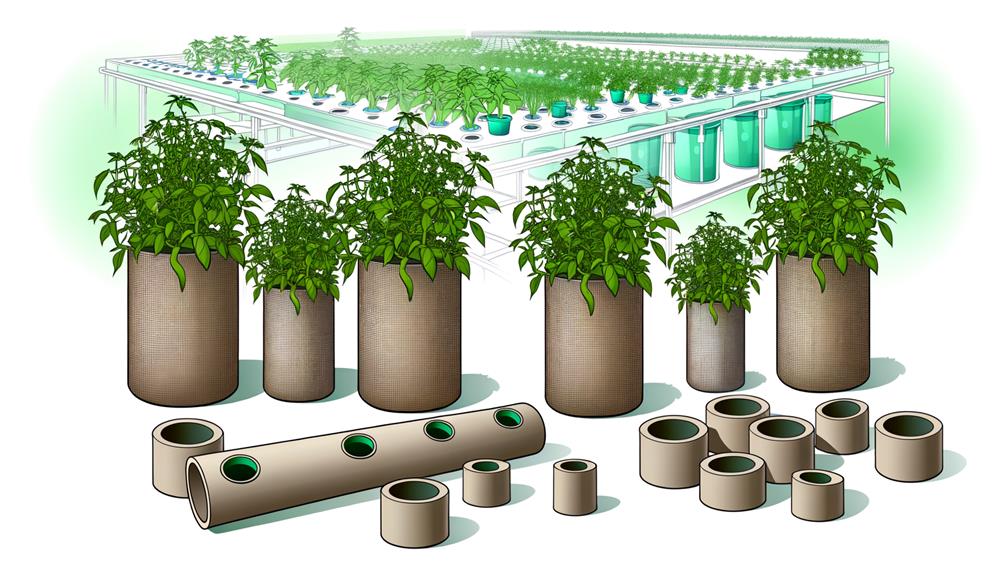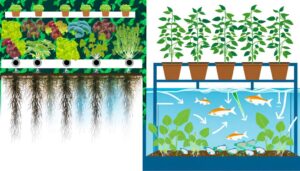What Size Net Pots for Hydroponics
In hydroponics, the right net pot size is critical for plant health and yield. We use smaller pots (2-3 inches) for leafy greens and seedlings, while herbs benefit from mid-sized pots (3-4 inches).
Larger plants like tomatoes and peppers need bigger pots (4-6 inches) for proper root development. System type also matters; Deep Water Culture (DWC) works well with larger pots, while Nutrient Film Technique (NFT) favors smaller ones.
Adequate root space and material durability, like polypropylene, guarantee ideal growth. Dive deeper into selecting the perfect net pot size to maximize your hydroponic success.

Key Takeaways
- Leafy greens and microgreens: Use smaller net pots (2-3 inches) for plants like lettuce and spinach.
- Larger plants: Opt for 4-6 inch net pots for plants such as tomatoes and peppers.
- Herbs: Choose mid-sized net pots (3-4 inches) for herbs like basil and cilantro.
- Growth stages: Start with smaller pots (2-3 inches) for seedlings, and transition to larger pots (4-8 inches) as plants mature.
Understanding Net Pot Sizes

Understanding net pot sizes is essential because they directly impact the root development and overall growth of hydroponic plants.
When we choose the right net pot size, we're ensuring that our plants have adequate space for root expansion. This directly influences nutrient uptake efficiency, oxygen availability, and overall plant stability.
Larger net pots, typically 6-8 inches, offer ample room for root systems to flourish, which is especially critical in deep water culture systems. Conversely, smaller net pots, around 2-3 inches, are best suited for young plants or microgreens where space isn't a limiting factor.
Plant Type Considerations
When selecting net pot sizes, we must consider the specific requirements of different plant types to guarantee ideal growth and root development.
For instance, leafy greens like lettuce and spinach thrive in smaller net pots, typically 2-3 inches, as their root systems are less extensive. Conversely, larger plants such as tomatoes or peppers necessitate more substantial net pots, often 4-6 inches, to accommodate their expansive root networks.
Herbs like basil and cilantro usually perform well in mid-sized pots, around 3-4 inches. By matching the net pot size to the plant type, we optimize water and nutrient uptake, ensuring robust plant health.
This tailored approach enhances overall efficiency in hydroponic systems, driving innovation and maximizing yield potential.
Growth Stage Impact

When considering net pot sizes for hydroponics, we must evaluate the plant's growth stage to guarantee ideal development.
Seedlings require smaller pots to support delicate root systems.
The vegetative stage demands increased space for expanding roots and nutrient uptake.
During the flowering stage, larger pots are essential to accommodate robust root structures and maximize yield potential.
Seedling Pot Size
Selecting the appropriate seedling pot size is essential as it directly influences the early growth stage and overall vigor of hydroponic plants.
When choosing net pots for seedlings, we should consider the delicate nature of young roots. Typically, a 2-inch to 3-inch net pot provides an ideal balance between root space and support. This size allows for sufficient aeration and nutrient uptake without overwhelming the seedlings.
Additionally, using appropriately sized pots minimizes transplant shock when we move the plants to larger systems. By carefully selecting the right seedling pot size, we can foster robust root development and set the stage for healthy, vigorous growth.
This meticulous approach lays the foundation for higher yields and more resilient plants in our hydroponic systems.
Vegetative Stage Needs
Understanding the specific needs of plants during the vegetative stage is vital for optimizing growth and guaranteeing robust development in hydroponic systems. We need to select the right net pot size to accommodate the expanding root systems and provide adequate support.
- Root Space: Larger net pots, typically 4-6 inches, are essential as they offer sufficient room for roots to spread and access nutrients effectively.
- Stability: Bigger pots provide greater stability for the growing plants, reducing the risk of tipping and assuring upright growth.
- Airflow: Adequate pot size guarantees proper airflow around the roots, preventing issues like root rot and promoting healthy development.
Flowering Stage Considerations
As plants progress from the vegetative to the flowering stage, the choice of net pot size continues to play an essential role in ensuring ideal nutrient uptake and structural integrity.
During this phase, root systems expand considerably, necessitating larger net pots, typically 6-8 inches, to accommodate increased root mass and support heavy flowering. Larger pots minimize root binding, allowing for best oxygenation and nutrient absorption.
We must also consider the stability of the plant, as larger pots provide a more robust anchor, important for supporting the weight of mature flowers.
Additionally, adequate space in the net pots facilitates better drainage and prevents waterlogging, which is critical for maintaining root health and overall plant vigor during this significant growth stage.
Root Space Requirements
Let's examine how root space requirements influence ideal root expansion, plant growth stages, and nutrient absorption efficiency.
By choosing the right size net pot, we can guarantee that roots have enough space to grow and access nutrients effectively.
This balance is essential for maximizing plant health and yield in hydroponic systems.
Optimal Root Expansion
Choosing the right size net pots is essential to guarantee your plants have ample root space for suitable expansion and nutrient uptake in hydroponic systems. In our experience, ideal root expansion hinges on a few critical factors.
- Root Volume: Larger net pots provide more room for roots to flourish, enhancing nutrient absorption.
- Plant Type: Different plants have varying root space needs; herbs may thrive in smaller pots, while larger plants like cucumbers require more extensive space.
- System Design: The design of your hydroponic system can dictate pot size. For instance, deep water culture systems often benefit from larger net pots for improved root aeration.
Plant Growth Stages
Understanding the root space requirements at different plant growth stages guarantees that we select the appropriate net pot sizes for ideal development.
In the seedling stage, smaller net pots (1-2 inches) suffice, providing a controlled environment for initial root growth.
As plants progress to the vegetative stage, their root systems expand rapidly, necessitating medium-sized net pots (3-4 inches) to accommodate increased spatial demands.
During the flowering or fruiting stages, large net pots (5-6 inches) become essential, ensuring ample room for extensive root networks.
By matching net pot size to each growth stage, we optimize root health and overall plant vigor, fostering an environment conducive to robust hydroponic cultivation.
This strategic approach underpins successful, innovation-driven hydroponic systems.
Nutrient Absorption Efficiency
Efficient nutrient absorption hinges on providing adequate root space, which allows plants to maximize their uptake of essential minerals and water.
It's essential to select net pots that cater to the root space requirements of different plant species. Here's why:
- Optimal Root Expansion: Ample space guarantees roots can expand freely, preventing entanglement and promoting healthy growth.
- Enhanced Oxygenation: Adequate room facilitates better oxygen flow to the roots, which is critical for nutrient uptake.
- Reduced Risk of Root Rot: Sufficient space prevents overcrowding, minimizing the risk of root diseases and rot.
System Compatibility

When selecting net pots for hydroponics, it's crucial to take into account the compatibility of the pot size with your specific hydroponic system to guarantee ideal plant growth.
Different systems, such as Deep Water Culture (DWC), Nutrient Film Technique (NFT), and Aeroponics, each have unique requirements. For DWC, larger net pots (3-6 inches) provide adequate root space and support. In contrast, NFT and Aeroponics benefit from smaller net pots (2-3 inches) to maintain proper nutrient flow and avoid clogging.
Ensuring the pot size aligns with your system's design prevents root binding, optimizes oxygenation, and enhances nutrient uptake. Consequently, carefully matching net pot size with your hydroponic setup fosters robust plant development and maximizes efficiency.
Material and Durability
Selecting net pots made from durable, high-quality materials is essential to guarantee longevity and resilience in hydroponic systems. We need to take into account the materials' resistance to moisture, UV light, and potential chemical interactions. Generally, robust plastic types like polypropylene and polyethylene are favored due to their durability and lightweight nature.
Here are three critical factors we should evaluate:
- UV Resistance: Ensures the net pots won't degrade or become brittle when exposed to light.
- Chemical Compatibility: Prevents any adverse reactions between the net pot material and the nutrient solutions.
- Structural Integrity: Ensures that the net pots can support plant weight and root expansion without collapsing.
Cost Efficiency

Balancing the initial investment with long-term benefits is essential in determining the cost efficiency of net pots for hydroponics.
We need to evaluate the upfront cost against the lifespan and performance of different pot sizes.
Smaller net pots typically cost less, but they may limit root expansion, potentially reducing plant yield and overall system efficiency.
Larger net pots, while more expensive initially, allow for better root development and can support more substantial plant growth, leading to higher yields.
As a result, calculating the return on investment (ROI) is vital.
Common Mistakes to Avoid
To enhance our hydroponic system's efficiency, we must be aware of common mistakes that can undermine the benefits of choosing the right net pot size.
First, selecting pots that are too large or too small can stifle root development, leading to less-than-ideal plant growth.
Second, neglecting to take into account the type of plant we're growing can result in inadequate support and nutrient distribution. Each species has specific needs that must be met.
Third, failing to factor in system scalability can limit future expansion. Starting with appropriately sized net pots guarantees flexibility and growth potential.
By avoiding these pitfalls, we can:
- Guarantee optimal root development.
- Match net pot size to plant requirements.
- Plan for future system scalability.
Let's aim for innovation and precision in our hydroponic endeavors.
Conclusion
In summary, choosing the right net pot size for hydroponics is essential to the health and productivity of our plants.
We must consider plant type, growth stage, root space, and system compatibility.
Let's not forget material durability and cost efficiency.
Remember, 'an ounce of prevention is worth a pound of cure.'
By avoiding common mistakes, we're setting our hydroponic system up for success, ensuring robust growth and abundant yields.
Let's make informed decisions for thriving gardens.






